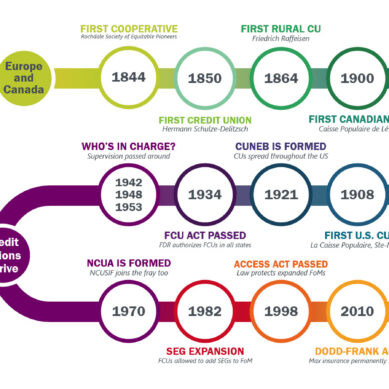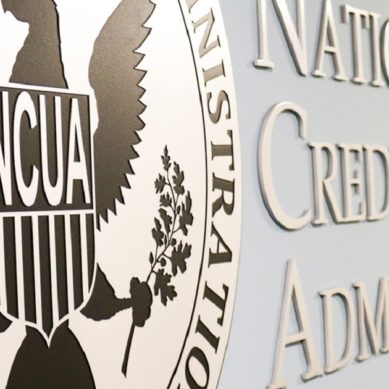Mergers and acquisitions are rife within the credit union industry. They have been at the forefront of industry news, discussions, and predictions for years now, and are unlikely to step aside anytime soon.
Since 2010, there have been 2,676 credit union mergers (not including 2023), with the total number of federally-insured credit unions decreasing from 7,339 to 4,712. The necessity of these mergers has often been scrutinized and criticized, with opponents claiming they are simply the result of a failure to have a strong succession plan or stemming from a desire to increase a credit union’s size simply for the sake of scale, rather than a true need to merge for the betterment of the credit union and its members.
The data seems to support this idea. In the first quarter of 2023, the NCUA approved 33 credit union mergers, only three of which were due to “poor financial condition.” 27 of the 33 were merging to “expand service offerings” (i.e. increase scale) and the final three were merging because of “an inability to secure officials” (i.e. lack of succession planning). Five of those mergers occurred between credit unions all over $50 million in asset size.
In fact, the largest merger of that group was between the $1.8 billion Northwest Community Credit Union into the $2.2 billion Twinstar Credit Union and the second largest was the $1 billion RTN Federal Credit Union with the $1.3 billion Merrimack Valley Federal Credit Union. Both mergers listed “expanded service offerings” as their primary reason for the merger. However, one has to wonder what service a credit union with $1.8 billion in assets could be failing to provide that it needs a $2.2 billion credit union to compensate for.
Furthermore, while the number of overall credit unions is quickly decreasing, the asset sizes of the remaining credit unions are increasing. As the Financial Brand points out, “In 1979, there were over 10,000 credit unions with assets less than $1 million. As of Q4 2021, there were fewer than 1,050 credit unions with assets less than $10 million. By contrast, there were only three $1 billion credit unions in 1979, whereas over 350 exist today.”
The overall takeaway? Fewer, but larger credit unions. An industry-wide consolidation.
Trade groups and CUSOs are following their lead
This consolidation is not limited to credit unions either. As credit union numbers dwindle (despite the increase in asset sizes), credit union trade groups and credit union services organizations (CUSOs) are finding that these changes will in turn affect their business plans. After all, the fewer the credit unions, the smaller the market for them to operate within.
Back in August, the two major credit union trade groups, the National Association of Federal Credit Unions (NAFCU) and the Credit Union National Association (CUNA) announced their intention to merge into one entity called America’s Credit Unions. NAFCU President/CEO Dan Berger cited industry consolidation of one among many justifications for the merger.
“The reality came for a lot of folks with the ongoing consolidation in our industry, “said Berger, in an interview with CU Times. “When I started here, I guess it was 14 or 15,000 credit unions or something. And now there’s 4,700. The movement, the industry, can’t afford two national trade associations. It’s just not a sustainable business model from a business sense.”
Now, PSCU and Co-op Solutions, two of the largest CUSOs in the nation in the payments space are following suit and announcing their merger, which will go into effect around the same time as CUNA/NAFCU merger.
At first glance, these large-scale mergers and decreasing credit union numbers can appear to be cause for concern, and they have most certainly raised the alarm for the past few years. And perhaps rightfully so—after all, losing valuable credit unions and CUSOs and the unique perspectives they brought to the industry is a great loss, as Chip Filson notes. However, this level of consolidation may in fact signal something less worrisome: that credit unions are solidifying their place in the market rather than losing it.
The Consolidation Curve
Consolidation and mergers in the industry have often been regarded as a loss or tragedy, and in some ways, they certainly can be, but they are also signs of an industry maturing and settling. Ultimately, both are natural processes for an industry to undergo as it ages, and the credit union industry is no exception.
In fact, the recipe for consolidation is so standard that a four-stage process, coined “The Consolidation Curve,” was created by Harvard Business Review in 2002 to chart the path all industries go through. The Consolidation Curve was developed from a study of 1,345 large mergers completed over the 13 years prior to publication. In it, they split industries into four distinct stages of consolidation: Opening (i.e. industry breakoff or beginnings), Scale (leaders emerge and begin scooping up late-comers), Focus (industry is controlled by 5-12 major parties), and lastly Balance & Alliance (top 3 companies control the vast majority of the market).
The name of the game is for any participant (i.e. company) in an industry to traverse the four stages and reach the final stage of the process first. By doing so, they secure themselves as an industry leader and market dominator. Think of Pepsi and Coca-Cola as examples in the soft drink industry. They face little to no competition with any company apart from each other and lead greatly in market share.
Of course, getting to stage four is no easy feat, as it requires surviving stages two and three, where a great number of mergers and acquisitions take place, lowering the total number of players in the game and increasing the size of those remaining. Sound familiar? It should, as these are the stages the credit union industry is currently balancing between. While still in stage two, the industry is showing signs that it is progressing into stage three, while CUSOs and trade groups are reaching even further, from stage three to four.
Credit unions are leaving stage two and entering three
In stage two of the Consolidation Curve, mergers increase at an unprecedented rate for the industry as players seek to expand, grow their market share, and stay in the game. This has been playing out in the credit union industry for the last decade or so, with some years seeing upwards of 260 mergers, for a total loss of 35% of total credit unions since 2011.
Furthermore, mergers taking place during stage two are rarely mergers of equals but instead consist of larger players absorbing smaller ones. But, as the industry heads into stage three, these dynamics change, and we’re beginning to see such changes occurring with credit unions.
Fewer mergers
First mergers slow down, though they don’t stop altogether. For credit unions, this seems to be the case (though it might be too early to say for certain). From 2010-2016, the industry saw over 200 mergers each year, with the lowest being 210 and the highest being 262.
However, since 2017, numbers haven’t crossed the 200 mark again and have reached as low as 143 in 2019 and 130 in 2020, according to NCUA numbers. It’s possible these numbers may rise in coming years, but it seems unlikely that they will reach their peak from the early 2010s.
Mergers of equals
Second, mergers that take place in stage three tend to differ in size from those in stage two. Think Insight notes, “As competitors compete to be among the last ones standing, the number of mergers begins to decline, but their size increases. Stage three consolidation plays are typical mergers of equals as opposed to stage two acquisitions, where larger competitors typically gobble up smaller, weaker competitors.”
This also aligns with merger trends in the credit union industry. According to a 2020 whitepaper published on WilWinn, since 2016 (around the same time merger numbers began decreasing), 79% of merger activity has been between credit unions with a 0-10% difference in asset size or a merger of equals. Only 10% had an asset-size disparity of 20% or greater.
Consider the previously mentioned merger between the $1.8 billion Northwest Community Credit Union into the $2.2 billion Twinstar Credit Union. Out of context, it might seem odd for a $1.8 billion credit union and a $2.2 billion credit union to combine for the sake of “expanded services,” but in the context of the Consolidation Curve, it’s clear that these larger credit unions are aiming to make it ever closer to stage four through a merger of (near) equals.
Mega-deals
Think Insight goes on to note that stage three is “distinguished by mega-deals and large-scale consolidation plays. The goal now is to establish itself as one of the few global industry powerhouses.”
It’s entirely possible to categorize both the CUNA and NAFCU merger and the PSCU and Co-op Solutions merger as stage three mergers. NAFCU and CUNA are positioning themselves and the newly created America’s Credit Unions as the leading credit union trade organization, while as the top two CUSOs in the nation for payments, with nearly 2,000 credit union owners between the two of them (the largest of any other CUSOs in the nation), PSCU and Co-op Solutions are aiming to lead in the service organizations space.
Is stage four in sight for some?
The argument could also be made that the PSCU and Co-op Solutions merger is teetering on stage four territory. If we look at it through the lens of stage four, the definition from Think Insight seems to fit.
“[In stage four] large companies may form alliances with their peers because growth is now more challenging…Thus, firms in these industries must defend their leading positions. They must find new ways to grow their core business in a mature industry…They must be alert to the potential for industry regulation and the danger of being lulled into complacency by their own dominance.”
As PSCU and Co-op Solutions were already secure in their position as the largest CUSOs in the payment space with the most credit union owners, it seems possible that this move was a case of seeking new growth where it might otherwise be challenging to do so. This does not necessarily mean that the merger has pushed these two CUSOs into the final stage of the Consolidation Curve but it certainly brings them ever closer.
Mergers will balance out
None of this is to say the number of mergers the industry sees each year is not something to worry about or monitor, or that every merger fits into the inevitable mold of the Consolidation Curve.
There are still plenty of avoidable and unnecessary mergers happening each year as a result of failed succession planning and other oversights. The loss of any credit union is a sad thing for a community, necessary or otherwise.
More than anything, this mold does offer a silver lining: that the mergers will slow and settle as our industry matures. But that doesn’t mean we can relax and wait for them to slow themselves or that the mold is one-size-fits-all for every industry, including our own.
It might be time to ask whether or not the path we are on is the right path for our industry. Does our industry define itself as one of competition and profit in which it aims to have a handful of credit unions accounting for the majority of the market share? As credit unions grow in asset size and consolidate into even larger ones, how does this affect our cooperative principles and dedication to our communities? Does the industry benefit from fewer, larger credit unions?
Credit unions can better position themselves to avoid such mergers by creating a solid succession plan, actively encouraging member participation in leadership and voting roles, and seeking ways to grow outside of consolidation. It is on us to decide which path we want our industry to go down and make the choices that will get us there.

























































